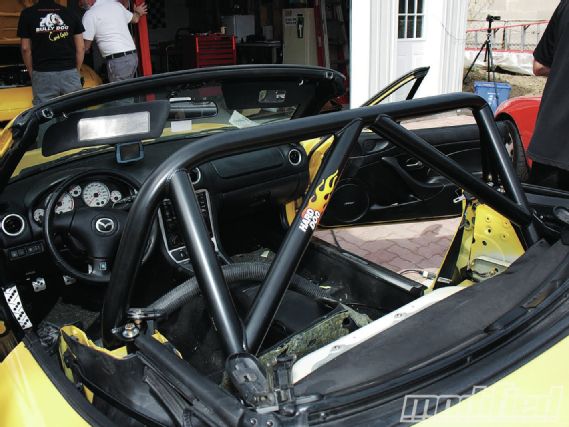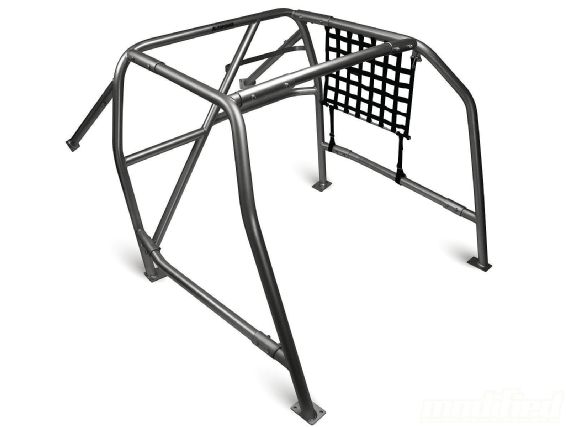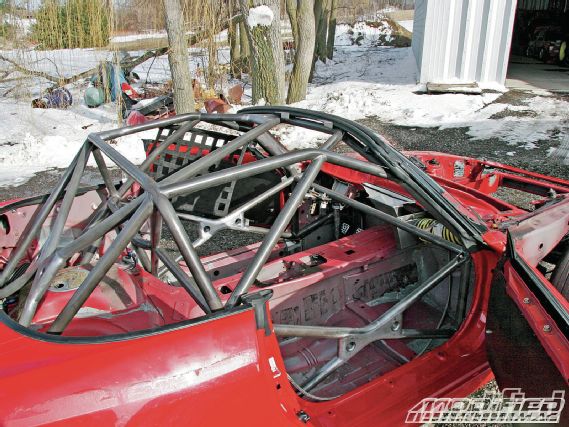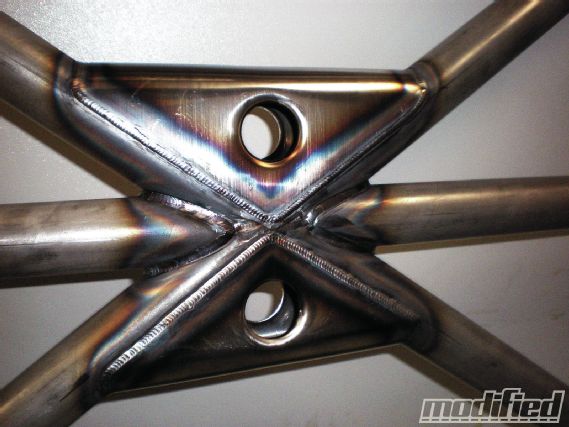 Learning The Rollover Ropes - Tech Talk
Learning The Rollover Ropes - Tech Talk
Having been racing for a decade or so now, I’ve read just about every rulebook there is out there, from SCCA and NASA pro racing, right down to grassroots-level time attack and autocross. Despite all the so-called experts on the Internet spouting off about how bolt-in rollcages are illegal and how you’re going to bash your head against that rollbar you’re thinking about installing, there’s a surprisingly consistent set of rules out there with respect to rollbar and rollcage design, fabrication and installation; as long as you follow these guidelines, the end result should be a safe and legal rollover protection structure for just about any type of racing you’ve got in mind.
 |
There’s no simpler rollover protection structure than a bolt-in rollbar, but even this relatively basic approach can save your neck (literally!) in the event of a rollover.
|
There’s no simpler rollover protection structure than a bolt-in rollbar, but even this relatively basic approach can save your neck (literally!) in the event of a rollover.
If you read the rollbar and/or rollcage rules for just about any solo, time trial, road racing or drifiting series in North America, the specifications are taken from the SCCA’s General Competition Rules (Appendix I for rollcages and the Solo Rules Appendix C for rollbars). This makes perfect sense, given that the SCCA is one of the oldest and most established motorsports sanctioning body in America, so using its highly refined rollover protection rules allows competitors to build their rollbars or rollcages in a manner that’s proven to be safe and compatible with pretty much any series they decide to race in.
Before taking a closer look at these specifications and discussing some of the pros and cons to the options available within them (bolt-in versus weld-in, ERW versus DOM versus chromoly), it’s important (if rather obvious) to recognize the fact that the purpose of a rollbar or rollcage is to protect the driver in the event of a rollover (in the case of a rollbar) and to protect him should his car come in contact with a barrier or another car (in the case of a rollcage). In fact, Section 9.4.1 of Appendix I in the SCCA GCRs states, “The basic purpose of the rollcage is to protect the driver if the car turns over, runs into an obstacle such as a guardrail or catch fence, or is struck by another car. It shall be designed to withstand compression forces from the weight of the car coming down on the rollover structure and to take fore/aft and lateral loads resulting from the car skidding along on its rollover structure.” Can’t be much clearer than that.
 |
A bolt-in SCCA and NASA legal rollcage from a manufacturer like Autopower is a relatively simple design, making it cost-effective and easy to install.
|
A bolt-in SCCA and NASA legal rollcage from a manufacturer like Autopower is a relatively simple design, making it cost-effective and easy to install.
That’s universal rule #1: the rollbar or rollcage is there to protect the driver, and in order to do so it must be built of appropriately strong materials, fastened to the car in an appropriately secure fashion, and padded (with high-density, energy-absorbing foam, not that low-density “pool noodle” stuff) anywhere the driver’s helmet might come in contact with it. Actually, that’s universal rule #2, because universal rule #1 is and always will be: wear a helmet!
Speaking of helmets, the classic saying, “Wear a $5 helmet if you’ve got a $5 head” is both catchy and condescendingly apropos, but some actual useful information would be that in the case of full rollcages, just about every sanctioning body requires the driver to wear a SA-rated (for motorsports) helmet, while for rollbars used in lower-speed and lower-risk forms of racing like solo and HPDE, the use of a less expensive M-rated (motorcycle) helmet is permitted. For more info on helmets, go to soloracer.com.
 | A more elaborate custom rollcage design like we opted for in our S2000 project provides a lot more rigidity to the chassis and greater protection for the driver as well.
| A more elaborate custom rollcage design like we opted for in our S2000 project provides a lot more rigidity to the chassis and greater protection for the driver as well.
OK, back to rollbars and rollcages. When building either (or shopping for pre-fabricated versions from manufacturers like Autopower Industries and Kirk Racing), the first thing you’ll need to do is make sure the tubing used is made of the right material and is of the right diameter and wall thickness. As stated in the SCCA rollbar and rollcage rules, seamless ERW, DOM mild steel (SAE 1010, 1020, 1025), and chromoly (SAE 4130) tubing is permitted, though ERW is advised against due to quality-control issues when manufacturing this type of tubing (and some sanctioning bodies are even excluding it from their permitted materials list). DOM mild steel is less expensive than chromoly and is therefore the most common choice, but because of chromoly’s strength, smaller-diameter tubing and/or thinner walled tubing is permitted, so there are some weight savings to be found there. However, chromoly welds are meant to be normalized, where the whole cage structure is heated up and then allowed to gradually cool, and given the challenge this presents, most fabricators opt for DOM mild steel tubing instead.
If your plan is to buy a SCCA-legal, bolt-in rollbar or rollcage, then all you really need to do is make sure the bar or cage meets all of the required SCCA specifications (manufacturers like Autopower offer SCCA-approved bars and cages, but if you’re paranoid you can also check with your sanctioning body on the legality of these products before buying one). It’s also important to make sure the mounting plates are 3/16-inch thick for bolt-in bars or cages, that at least three bolts per plate are used, and that all bolts and nuts are SAE Grade 5 or better and are at least 5/16-inch in diameter. A rollbar or cage from Autopower comes with all the required hardware, so it only takes a few hours to install, though drilling holes in your car’s chassis definitely tests your commitment.
For all you JDM lovers out there, it’s worth noting that the ever-popular Cusco rollcage is not SCCA legal. In Japan these rollbars/cages are MOT legal, but because they’re designed for RHD vehicles and some of their design elements aren’t SCCA compliant (tubing wall thickness is too thin, for example), you won’t pass tech inspection at a race event in North America with one of these in your car. The same is true of a lot of other foreign market rollbars and rollcages, so make sure to check material, tubing diameter and tubing wall thickness if you plan to do any type of racing that requires rollover protection.
It’s also worthwhile noting that fitment of bolt-in rollbars and rollcages generally aren’t going to be as tight against the roof and A- and B-pillar areas as a well-designed weld-in cage, so in the event of a rollover there will be more crush damage to the car. Bolt-in cages are also less stable than weld-in cages — the bolted joints being the weak link in the design. But given their ease of installation and removability, they can be the right choice for your project and still offer adequate rollover protection, given that they meet with SCCA approval.
 |
Gussets (sometimes made of dimple-die sheetmetal) added to door bars and other critical areas of the cage structure is one way that custom rollcage fabricators add strength to their designs, not to mention some eye-catching craftsmanship.
|
Gussets (sometimes made of dimple-die sheetmetal) added to door bars and other critical areas of the cage structure is one way that custom rollcage fabricators add strength to their designs, not to mention some eye-catching craftsmanship.
With a weld-in cage, you can incorporate a lot of design elements that add stiffness to the chassis and rigidity to the cage, plus you can fit the cage very tightly against the pillars and roof so that damage to the car is minimized in a rollover. For purpose-built race cars, a weld-in cage is always going to be the best option. If you get a chance to take a peek inside a top-shelf professional race car, you’ll notice that its rollcage structure incorporates a lot of triangular shapes into its design, since a properly triangulated rollcage provides a lot of added strength to the structure. You’ll also notice all the “corners” and other areas where there are bends or joints that gussets or dimple-died sheetmetal is used to reinforce the area. And if the rules allow it, you’ll also notice the cage is extended through the firewall to the front strut towers for added strength and crush protection, not to mention more extensive door bars to thoroughly protect the driver.
A professionally built cage ain’t cheap (usually around $3,000 to $5,000), but just like that $5 helmet analogy implies, if you’re going racing, the first place to spend your money is on safety equipment. If you start by making sure the rollover protection you install meets the regulations of the sanctioning body you’re going racing with, then make sure it’s installed correctly; you should have no problems passing tech and, most importantly, walking away from a rollover.
 |
Learning The Rollover Ropes - Tech Talk
|
Learning The Rollover Ropes - Tech Talk
Send your feedback to dpratte@modified.com
